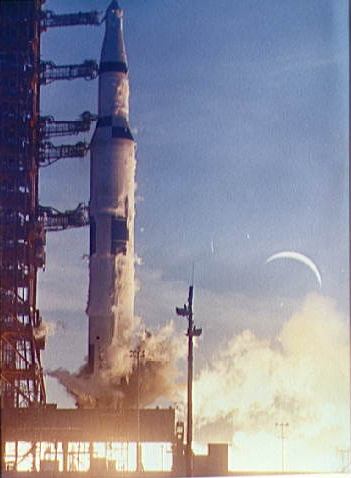The Political/Social Issues of Human Space Exploration
The main Launch Programs by NASA for Human Space Exploration were (are):
 Project Mercury Initiated in 1958, completed in 1963, Project Mercury was the United States' first man-in-space program.
Project Mercury Initiated in 1958, completed in 1963, Project Mercury was the United States' first man-in-space program.
Project Gemini Announced in January 1962, Gemini involved 12 flights, including two unmanned flight tests of the equipment.
Skylab Designed for long duration missions. First launched in 1973, Skylab (empty) fell to earth in 1979. Mission was to prove that humans could live and work in space for extended periods, and to expand our knowledge of solar astronomy well beyond Earth-based observations.
Apollo The Apollo program included a large number of uncrewed test missions and 11 crewed missions. The 11 crewed missions include two Earth orbiting missions, two lunar orbiting missions, a lunar swingby and six Moon landing missions. Total Funding: $19,408,134,000 (34% of NASA Budget).
 Apollo-Soyuz The mission started with the Russian Soyuz launch on July 15, 1975, followed by the U.S. Apollo launch on the same day. Docking in space of the two craft occurred on July 17, and joint operations were conducted for two full days. Both spacecraft landed safely and on schedule.
Apollo-Soyuz The mission started with the Russian Soyuz launch on July 15, 1975, followed by the U.S. Apollo launch on the same day. Docking in space of the two craft occurred on July 17, and joint operations were conducted for two full days. Both spacecraft landed safely and on schedule.
The Space Shuttle The space shuttle is the world's first reusable spacecraft, and the first spacecraft in history that can carry large satellites both to and from orbit. The shuttle launches like a rocket, maneuvers in Earth orbit like a spacecraft and lands like an airplane.
Space Station In 1998, the first two modules of the International Space Station were launched and joined together in orbit. Other modules soon followed and the first crew arrived in 2000.
What is the benefit to Society of a Space Program?
Foremost, scientific investigation of the Sun, the solar system and the Earth and its
weather and oceans. Secondly, satellite communication, GPS, etc. Finally, the development of new technologies useful for us on Earth but which were initially movitated by space exploration.
The cost of billions of dollars a year is still a small percent of what is spent on military programs. More work is being done in collaboration with other countries to share the costs. Indeed, space exploration should be a shared endeaver which unites us.